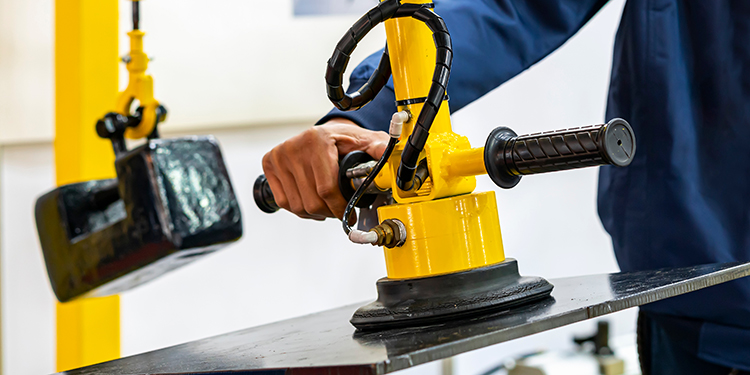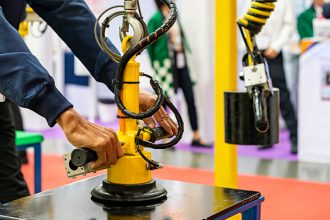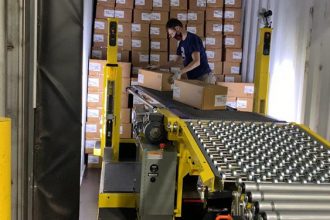How Three Different Ergonomic Assist Devices Support Social Distancing

Many operations require two associates to lift, handle, and manipulate loads weighing more than 50 pounds as a means to reduce the risk of injury associated with manually moving heavy items. While this measure may help decrease the chance of back and shoulder strains, it does very little to safeguard employees from potentially being exposed to a virus — such as COVID-19. That’s because lifting in tandem can rarely be accomplished while maintaining a minimum of 6 feet distance apart.
However, companies that add ergonomic assist devices within their operation enable a single worker to handle the tasks that previously required two employees, thereby reinforcing social distancing. Ergonomic assist systems and equipment can also enhance productivity, which has become even more important now that facilities have had to implement enhanced cleaning and disinfection processes into their workforce’s daily routines. With these devices in place, the second worker to be reallocated to another task — an advantage that existed before the onset of the pandemic, when companies faced ongoing challenges with hiring and retaining a qualified workforce.
Here are a few examples of how ergonomic assist solutions can support social distancing:
Workstation Cranes: Frequently found in manufacturing and assembly operations, workstation cranes help workers lift, handle or move heavy objects ergonomically in order to perform various processes. Capable of handling loads weighing up to 4,000 pounds, these overhead lifting and positioning systems allow one worker to precisely maneuver and place a load in a work cell without the risk of an injury associated with overexertion. Additionally, with a workstation crane, a single worker can handle a task — such as rotating, turning, moving or positioning a heavy workpiece — without the assistance of a colleague, enhancing safe distancing practices.
Self-Leveling Carts: Whether pushed manually or towed as part of a train, a cart for load movement can be outfitted with a spring-loaded, self-leveling platform. These mechanical systems allow a stack of items — such as empty pallets or trays full of component parts — to automatically lower or raise as items are placed on or removed from the cart. For example, such a cart can be used to collect empty pallets at the end of a process; because the platform automatically lowers as each pallet is placed upon it, the top-most level remains at a safe, ergonomically optimized height that minimizes worker strain. It also allows a single operator to load the cart, as the need for stretching or reaching is eliminated. This enables an operation to maintain process efficiency with a single worker while minimizing employee interaction.
Powered Wheels and Casters: When equipped with powered wheels and casters that are driven by an electric, battery-powered drive system, a material handling cart that previously required two operators to maneuver it can be controlled by just one. That’s because the powered wheels and casters virtually eliminate all physical exertion associated with pushing, pulling, starting or stopping a wheeled load on flat, inclined or declined surfaces. The powered wheels and casters can generally handle loads up to 1,200 pounds per wheel, and — instead of relying on physical, manual labor to start or stop the motion of the cart — the operator only needs to push a button. With just one associate required to move the cart, workers can be separated and assigned to different tasks to reduce interpersonal contact while still maintaining operational productivity.
Looking for more ways to improve ergonomics in your manual material handling operation? Download the free publication, “Ergonomic Guidelines for Manual Material Handling,” published by the members of MHI’s Ergonomic Assist Systems & Equipment (EASE) Industry Group.



